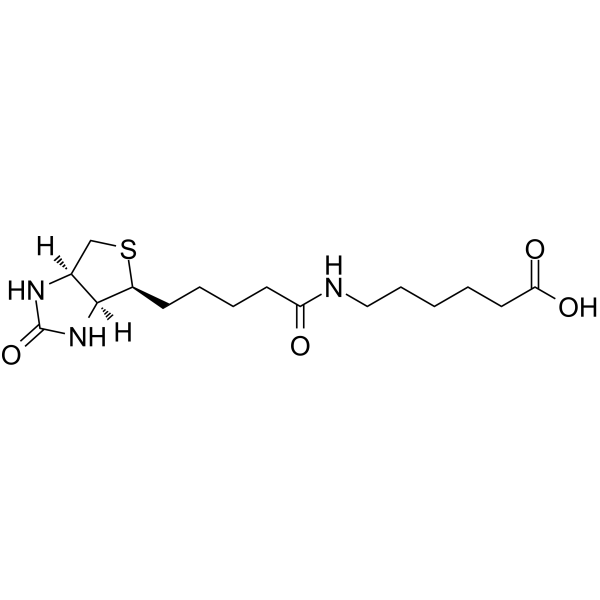
N-Biotinyl-6-aminohexanoic acid
CAS No. 72040-64-3
N-Biotinyl-6-aminohexanoic acid( N-(+)-Biotinyl-6-aminohexanoic acid )
Catalog No. M27092 CAS No. 72040-64-3
N-Biotinyl-6-aminohexanoic acid can be used to perform N-terminal biotinylation.
Purity : >98% (HPLC)
 COA
COA
 Datasheet
Datasheet
 HNMR
HNMR
 HPLC
HPLC
 MSDS
MSDS
 Handing Instructions
Handing Instructions
| Size | Price / USD | Stock | Quantity |
| 5MG | 45 | In Stock |


|
| 10MG | 63 | In Stock |


|
| 25MG | 103 | In Stock |


|
| 50MG | 150 | In Stock |


|
| 100MG | 223 | In Stock |


|
| 500MG | 482 | In Stock |


|
| 1G | Get Quote | In Stock |


|
Biological Information
-
Product NameN-Biotinyl-6-aminohexanoic acid
-
NoteResearch use only, not for human use.
-
Brief DescriptionN-Biotinyl-6-aminohexanoic acid can be used to perform N-terminal biotinylation.
-
DescriptionN-Biotinyl-6-aminohexanoic acid can be used to perform N-terminal biotinylation.(In Vitro):The SERS (surface-enhanced Raman scattering) of cyclohexyl isocyanide that silver nanoparticles modified with N-Biotinyl-6-aminohexanoic acid and cyclohexyl isocyanide can be anchored on a separate biotinylated substrate via the avidin-biotin interaction.Synthesis of p-nitrophenyl N-acetyllactosaminide with β-D-galactosidase, chemical reduction of the p-nitrophenyl group, and sialylation with sialyltransferase.?The p-aminophenyl glycosides are successfully biotin-labeled through the coupling with N-Biotinyl-6-aminohexanoic acid to afford biotinylated oligosaccharides with an aminohexanosyl group and phenyl group as the spacers between the biotin and glycan.?The biotin-labeled sugars were shown to be useful for immobilization and assay of the carbohydrate-lectin interactions by an optical biosensor based on surface plasmon resonance.
-
In VitroSynthesis of p-nitrophenyl N-acetyllactosaminide with β-D-galactosidase, chemical reduction of the p-nitrophenyl group, and sialylation with sialyltransferase. The p-aminophenyl glycosides are then successfully biotin-labeled through the coupling with N-(+)-biotinyl-6- aminohexanoic acid to afford biotinylated oligosaccharides with an aminohexanosyl group and phenyl group as the spacers between the biotin and glycan.The SERS (surface-enhanced Raman scattering) of cyclohexyl isocyanide that silver nanoparticles modified with N-(+)-biotinyl-6-aminocaproic acid and cyclohexyl isocyanide can be anchored on a separate biotinylated substrate via the avidin-biotin interaction.
-
In Vivo——
-
SynonymsN-(+)-Biotinyl-6-aminohexanoic acid
-
PathwayOthers
-
TargetOther Targets
-
Recptor——
-
Research Area——
-
Indication——
Chemical Information
-
CAS Number72040-64-3
-
Formula Weight357.47
-
Molecular FormulaC16H27N3O4S
-
Purity>98% (HPLC)
-
Solubility——
-
SMILESO=C(O)CCCCCNC(CCCC[C@@H]1SC[C@]([C@]1([H])N2)([H])NC2=O)=O
-
Chemical Name——
Shipping & Storage Information
-
Storage(-20℃)
-
ShippingWith Ice Pack
-
Stability≥ 2 years
Reference
1.Kim KH, et al. 1-Carbomethoxy-β-Carboline,?Derived?from?Portulaca?oleracea?L.,?Ameliorates?LPS-Mediated?Inflammatory?Response?Associated?with?MAPK?Signaling?and?Nuclear?Translocation?of NF-κB.Molecules.?2019 Nov 7;24(22). pii: E4042.
molnova catalog



related products
-
1,1'-(4-CHLOROBUTYLI...
1,1'-(4-Chlorobutylidene)bis(4-fluorobenzene) is a derivative of Zerumbone with potential anti-tumor effects towards HeLa cancer cells.
-
Ivermectin B1a
Ivermectin B1a is the major (80%) component of commercially available ivermectin and a derivative of Avermectin B1a.
-
Fmoc-Ile-OH
Fmoc-Ile-OH (Fmoc-L-isoleucine) is an Fmoc-modified isoleucine with a strong affinity for peptides and proteins and can be used to synthesize other active compounds.



 Cart
Cart
 sales@molnova.com
sales@molnova.com


